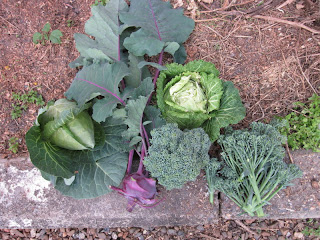Raining today - 10mm so far - whilst our tanks are reasonably full, it is welcome for the garden.
Two more edible weeds that are closely related
Binomial name :
Plantago lanceolataCommon name : Ribwort Plantain
and
Plantago coronopusCommon name : Buck's horn Plantain
We don't have
Plantago major on our property
The use of the name
Plantain is confusing, as there is a variety of banana also called this. I like to use proper (ie scientific or binomial) names for exactly this reason - there is no doubt what plant I am talking/writing about ,whereas with common names there can be confusion. The common name of plantain is from the latin
planta meaning sole (as in shoe) as the leaf shape is vaguely thus shaped, for Plantago major anyway.
Plantago sp (probably lanceolata) is a weed I remember from my childhood in New Zealand - we used to break off the seed stalks with seed head attached, make a loop from the stalk and use this to shoot off the seed head usually towards some other child ! Another game we played was to see how many times we could tear a leaf and still have it hang together ( explanation of this following).
Also in this family is Plantago psyllium, the seeds of which are processed to make the laxative metamucil.
Identification -for P lanceolata:
The rosette is abo

ut 400mm wide and 300mm high. Leaves are 200mm long and about40mm wide with 7 readily seen veins. Flowering stems are 500mm high with seed heads about 300mm x10mm thick. Each plant has up to 3 flowering stems/plant. If a leaf is broken into two there are strings evident which tie the two halves together. There is a fibrous root system
For Buck's horn p

lantain the leaves are somewhat jagged and the plant is overall of similar dimension to the former species. It has a pretty impressive taproot that measured 160mm on the specimen I pulled out. Any breaks in the plant - leaves and root exude a white sap as well.
History:
Plantago (especially P major) has a long and colouful usage by humans. It was found in the stomachs of the bog bodies from the late stone age in Denmark. It was mentioned by the Greek Physician Dioscorides from the first century. The Vikings recorded using it to heal wounds, and the Saxons venerated it as a sacred herb. Shakespeare mentioned it in Romeo and Juliet as a herb to heal.
In Act 1 Scene 2 - he writes:
ROMEO Your plaintain-leaf is excellent for that.
BENVOLIO For what, I pray thee?
ROMEO For your broken shin.
P coronopus was cultivated in Europe and England as a potherb for 300 years.
Young plantain leaves are eaten as a minor potherb in Europe, China and North America and the mucilaginous seeds are used in Asia to make a drink.
Nutrients:Not sure of actual amounts/100gm but the following are listed:
carotenoids, flavonoids, mucilage, calcium, monoterpene alkaloids, glycosides, sugars, triterpenes, linoleic acid, iridoids, and tannins.
Some of these are no real surprise, especially the carotenoids,alkaloids and tannins. Linoleic acid is a type of omega 3 fatty acid.
Pubmed search:There are lots of studies on Plantago species - here are a few:
1 P. asiatica essential oils decrease total cholesterol by blocking the same enzyme in the liver that Statin drugs ( eg Lipex) act on.
2.A number of Plantago sp especially P major have long been used in the treatment of diseases such as infection ,inflammation and cancer and in this study of 5 types of compounds from Plantago major on human white cells ( lymphocytes) it was found that there was an increase in lymphocyte proliferation and production of gamma interferon. This basically confirms traditional usage, as the result of those two things happening is basically to turn up our immune system.
3 P. asiatica also seems to have a compound in it that acts on the Angiotensin converting enzyme.Blocking this enzyme results in the lowering of blood pressure and this pathway is used in modern medicine by such drugs as Coversyl and Monopril and lots of others.
4. Finally another study showed that Plantago major had significant anti-inflammatory and anti-oxidant effects.
There is also lots more about this weed which is really interesting such as the traditional use for stopping bleeding and for treating wounds. No doubt it has anti-bacterial activity as well, and of course the usage as a laxative.
What part to eat:
Young leaves from young plants - blanch to remove bitterness.
We find P lanceolata too bitter and stringy to bother with. Tim Low in his book also makes the same comment.
P coronopus is more palatable, not stringy at all and has no bitter taste.
However, fascinating pubmed stuff on them generally.
Tom







































